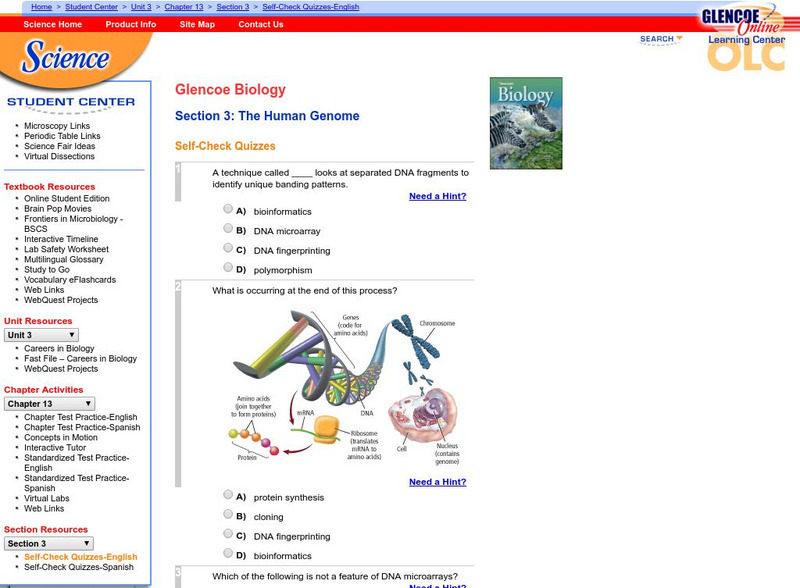Curated OER
Lesson 16: DNA Technology
Young scholars research different areas of biotechnology. In this biology lesson, students create a presentation about their research. They debate the topic presented and share their views on the subject.
Curated OER
The Genetics of Antibody Diversity
Students distinguish between the light and heavy chain sections. In this biology lesson, students simulate the DNA splicing process. They calculate antibody diversity using the information given.
Curated OER
The Challenge to Deliver Insulin
Students investigate these fundamental chemical and cellular processes. They recognize the long-term danger that comes from a diet of fast food, chips, and soda, realize that avoiding diabetes is their responsibility, and establish...
Curated OER
Who's the Father?
Students analyze gels to determine parentage in this lesson about scientific evidence, investigation, and DNA concepts. The lesson includes a pre-activity worksheet, a final individual assessment, and student handouts for in-class...
Curated OER
How HIV Infects Cells
In this how HIV infects cells instructional activity, students read the given information about how HIV infects cells. Students explain the role of various structures in HIV infection. Students design a drug that might slow the rate of...
Curated OER
Fungi
Why did the mushroom go to the party? Because he was a fun guy! Biology learners study fungi while completing this worksheet. Structure is compared to that of other life forms. The life cycle is displayed with colorful diagrams for...
Curated OER
Evidence of Evolution by Natural Selection: Testable Hypotheses #2
These slides will activate prior knowledge with real-life examples of natural selection. The predictions and outcomes for those examples are explained. Your students will like the information about the relevant chromosome tests that can...
Curated OER
BLAST Algorithm
Students explore a series of activities on using BLAST. In this biology lesson plan, students explain the significance of BLAST in DNA query. They give real world applications of BLAST.
Curated OER
The Hope of Science: DNA Practical Applications Time Line
Students design a time line to inform and educate people about the history of DNA practical applications.
Curated OER
Biotechnology
The metaphors used here to describe the "cut and paste" procedures for genetic engineering will really help your biologists in their understanding of restriction enzymes and DNA. The uses of genes that are isolated and incorporated...
Curated OER
A Little More Advanced Biotechnology Tools; Better Plasmids
After using this DNA and plasmids slide show, the steps of the delicate procedures of southern blotting and DNA libraries should be more clear to your students. Students will read the guidelines and are also prompted to answer...
Curated OER
Who am I and Why?
Students make comparisons about themselves and others, which are real and meaningful. They study some basic concepts in the area of genetics and do a complimentary series of experiments, or explorations that illustrate these concepts
Curated OER
Ghost in Your Genes
Learners explore DNA microarrays. In this genetics instructional activity, students model DNA microarrays that are used by scientists. Learners work to determine levels of breast cancer genes in patients. They will determine the...
Curated OER
Using VNTR Analysis to Identify Guilt at a Crime Scene
Students collect DNA from cheek cells. They compare and contrast the processes of DNA replication and PCR. They discuss how this information can be used to determine guilt at crime scenes.
Curated OER
Bioinformatics
Students are exposed to the tools and databases currently used by researchers in molecular and evolutionary biology. They gain a better understanding of gene analysis, taxonomy, and evolution.
Curated OER
Who Owns Rights to Pharmacogenetic Information?
Students develop an understanding of the rationale of ownership over scientific information. They research commercial applications of DNA sequences. They analyze how to evaluate medical ethics issues.
Curated OER
Genetically Modified Foods
High schoolers explain what genetically modified foods are and how they are created. Students use appropriate vocabulary to describe and effectively discuss the benefits of, and potential risks of, genetically modified foods.
Curated OER
DNA and RNA
Tenth graders research the history and discovery of DNA. Using their text, they label a basic DNA structure and the composition of genes. They explain how RNA and DNA differ from one other and discuss the processes of transcription and...
Curated OER
Genetic Ethics Debate
Students select topics relating to bioethical questions which they research and debate. They, in groups, select topics and are given two to three weeks to research their topics, taking advantage of their school libraries and local public...
Curated OER
DNA Sequencing Model Lab
Students pretend they are each genetic engineers with a test tube of unknown DNA (PCR'd) possibly taken from blood cells of someone with a genetic condition.
National Health Museum
Access Excellence: The Human Genome Project
This site from Access Excellence gives an introduction to the Human Genome Project. The page links to a graphics gallery and to discussions about related ethical issues.
McGraw Hill
Glencoe Biology: The Human Genome: Self Check Quiz
Take this quick self-checking, multiple-choice question quiz over the human genome.
Oak Ridge National Laboratory
Human Genome Project Overview
Explains the goals of the Human Genome Project. It also explains some of the ethical, legal and social challenges associated with this new technology.
National Institutes of Health
Ncbi: Human Genome Resources
This site covers information on all the human chromosomes, has interesting illustrations as well.






















